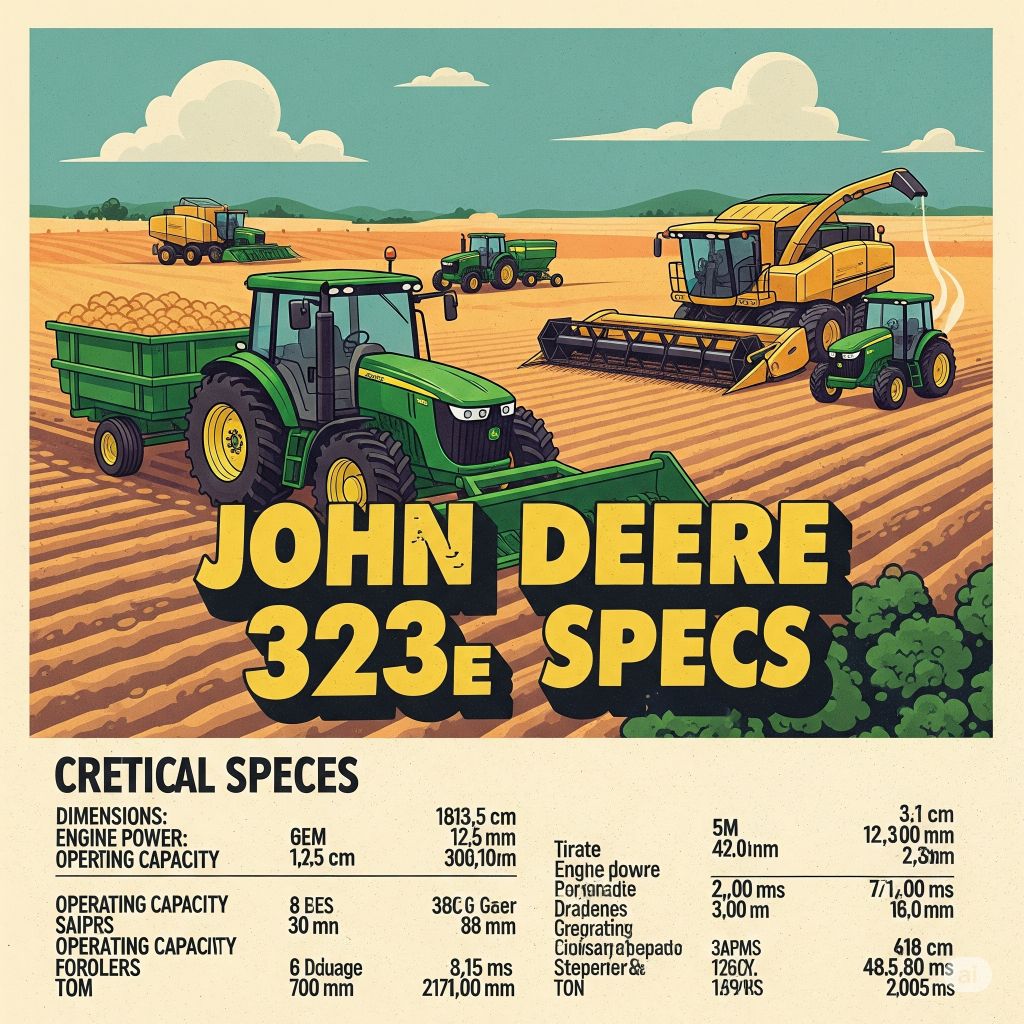
The John Deere 323E is a compact track loader designed for versatility, durability, and efficiency in construction and agricultural operations. Featuring excellent power and performance, it is a reliable choice for heavy-duty jobs and demanding environments. Below are the detailed specifications:
John Deere 323E Compact Track Loader Specifications
Engine
- Engine Model: Yanmar 4TNV98C
- Type: 4-cylinder diesel engine
- Gross Horsepower: 74 HP (54.8 kW) @ 2,500 RPM
- Net Horsepower: 70 HP (52.2 kW)
- Fuel Capacity: 19.5 gallons (73.8 liters)
The engine delivers powerful and efficient performance, making the loader suitable for a variety of heavy-duty tasks.
Dimensions
- Length (with standard bucket): 11 ft 5 in (3,480 mm)
- Width: 6 ft (72 inches / 1,829 mm)
- Height: 6 ft 9 in (2,057 mm)
- Ground Clearance: 11 inches (280 mm)
Its compact design allows for easy maneuvering in tight spaces without compromising on capability.
Operating Specifications
- Operating Weight: 9,440 lbs (4,286 kg)
- Rated Operating Capacity: 2,590 lbs (1,176 kg)
- Tipping Load: 7,400 lbs (3,360 kg)
- Bucket Breakout Force: 3,178 lbs (1,442 kg)
- Maximum Speed (forward/reverse): 6.8 mph (10.9 km/h)
The loader offers impressive lifting capacity and breakout force, making it ideal for tasks such as excavation, lifting, and material transport.
Hydraulic System
- Standard Hydraulic Flow: 18 GPM (gallons per minute)
- High-Flow Hydraulic Option: 25 GPM
- System Pressure: 3,250 PSI
- Hydraulic Horsepower (Standard): 33 HP
- Hydraulic Horsepower (High Flow): 47.1 HP
The machine is equipped with a robust hydraulic system that can handle a range of attachments, increasing its versatility.
Tracks
- Track Width: 12.6 inches (wide tracks available for better stability)
- Track Design: Rubber tracks for low ground pressure, improving traction in soft, wet, or rough terrains.
- Ground Contact Area: 1,464 square inches.
Reach and Dump Heights
- Loader Geometry: Vertical lift path
- Dump Height: 8 ft 2 in (98 inches)
- Reach at Maximum Height: 28 inches
This design allows for efficient loading into trucks and trailers.
Performance Features
- Attachment Versatility: Quick couplers support a variety of attachments like augers, breakers, and brooms.
- Cab Comfort: Equipped with an ergonomic operator seat, air conditioning, and large glass areas for better visibility.
- Advanced Controls: Joystick controls and optional keyless start for ease of operation.
- Durability: Sturdy frame and reinforced components for handling tough jobsite conditions.
Applications
- Excavation and trenching.
- Material transport on construction and farm sites.
- Landscaping and grading surfaces.
- Snow removal using relevant attachments.
John Deere 323E Loader: Common Problems and Solutions
The John Deere 323E is a high-performance compact track loader widely used in construction, landscaping, and agricultural industries. While it is reliable and efficient, specific issues can occur with regular use. Below, we will explore common problems with the 323E loader, their causes, and actionable solutions.
1. Hydraulic System Problems
The hydraulic system is a critical component of the loader, and many users report issues such as weak performance, slow movement, or hydraulic fluid leaks.
Causes:
- Contaminated or low hydraulic fluid.
- Worn-out hydraulic seals.
- Internal leakage in the hydraulic pump.
Solutions:
- Check and replace hydraulic fluid: Regularly inspect fluid levels and top it up with the manufacturer-recommended type.
- Repair leaking seals: Inspect seals on cylinders and hydraulic lines, replacing any damaged components.
- Inspect the hydraulic pump: If performance issues persist, check the pump for signs of wear or internal damage. Replace it if necessary.
2. Engine Overheating
Overheating is a prevalent issue, especially during extended operations in hot weather.
Causes:
- Clogged cooling fins or radiator.
- Insufficient coolant levels or poor-quality coolant.
- Faulty water pump or thermostat.
Solutions:
- Clean the radiator and cooling fins: Use a pressure washer or air blower to remove debris blocking the cooling system.
- Check coolant levels regularly: Refill or replace with high-quality coolant appropriate for the 323E.
- Inspect water pump and thermostat: Replace these components if they are not functioning correctly.
3. Power Loss
Some operators report a loss of engine power, reducing the machine’s efficiency under heavy loads.
Causes:
- Dirty or clogged fuel filters.
- Contaminated fuel or injector blockages.
- Worn-out air filters blocking airflow.
Solutions:
- Replace fuel filters: Clean or replace filters as necessary, following regular maintenance schedules.
- Inspect the fuel system: Use clean diesel fuel to prevent clogging of injectors.
- Replace air filters: Perform regular airflow maintenance to ensure maximum engine performance.
4. Track and Undercarriage Issues
Frequent use on rough terrain can cause problems with the tracks and the undercarriage system, such as abnormal wear or misalignment.
Causes:
- Loose track tension.
- Excessive debris lodged in the undercarriage.
- Worn rubber tracks.
Solutions:
- Adjust track tension manually: Follow the user manual to ensure correct tension settings.
- Clean the undercarriage regularly: Remove debris and inspect for signs of damage.
- Replace worn tracks: Install high-quality replacement tracks when signs of wear are evident.
5. Electrical Problems
Electrical failures, such as loss of power to lights, displays, or control systems, are often reported.
Causes:
- Corroded electrical connections or wiring.
- Blown fuses or relays.
- Faulty alternators.
Solutions:
- Inspect and clean connections: Prevent corrosion by using electrical grease and ensuring secure connections.
- Replace fuses or relays: Check the fuse box for damaged components.
- Test the alternator output: Replace if it fails to provide sufficient charge.
6. Final Drive Motor Issues
Gear and final drive lubrication problems can cause noises, reduced speed, or complete loss of drive.
Causes:
- Low gear oil levels.
- Damage to the motor bearings or gears.
- Contamination of the drive motor.
Solutions:
- Check gear oil levels regularly: Refill and replace as per maintenance schedules.
- Inspect motor bearings and gears: Replace worn components to prevent system failure.
- Prevent contamination: Use clean oil and fix seals that may allow dirt infiltration.
Preventive Maintenance Tips
To minimize these issues, prevent downtime, and extend the lifespan of your John Deere 323E, consider the following maintenance practices:
- Inspect hydraulic systems and replace filters every 200 operating hours.
- Clean cooling systems and radiators after long or heavy operations.
- Service the fuel system regularly and avoid using stale or contaminated fuel.
- Perform undercarriage cleaning after every task to prevent debris buildup.
- Inspect electrical connections and replace worn components periodically.
Summary
The John Deere 323E loader is a versatile and dependable piece of equipment with excellent capabilities. However, like any machine, it is prone to wear and tear that can result in common issues. By addressing hydraulic, engine, track, electrical, and final drive problems proactively and following a consistent maintenance schedule, operators can ensure optimal performance and reduce downtime.
For more detailed troubleshooting guides or professional assistance, refer to the official John Deere user manual or visit an authorized service center.

I’m David man behind Lawn Mowerly; I’ve been dealing with lawnmowers and Tractors with my father since I was a kid. I know every make and model and what each one is capable of and love helping people find the perfect lawn mower for their needs.
